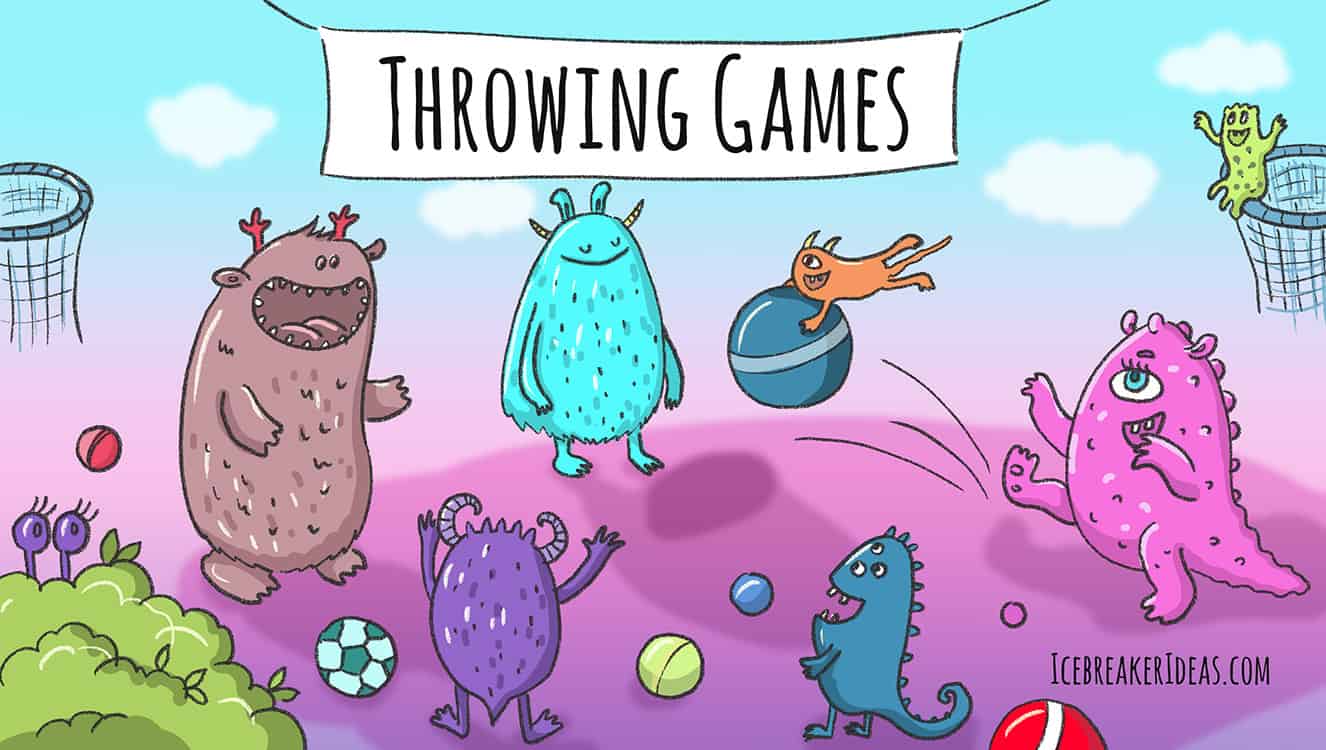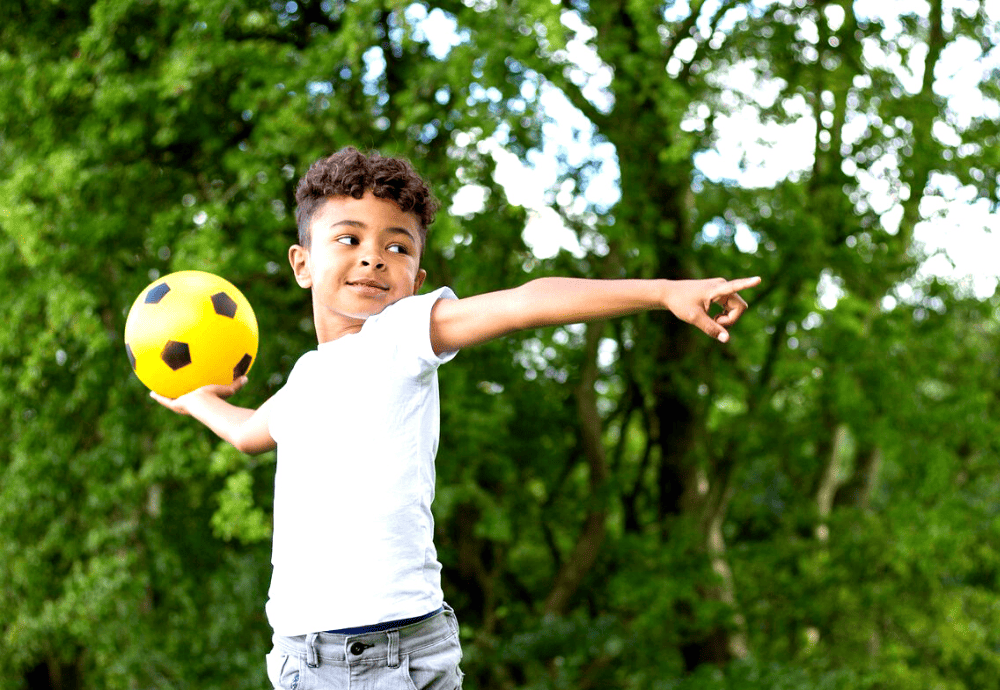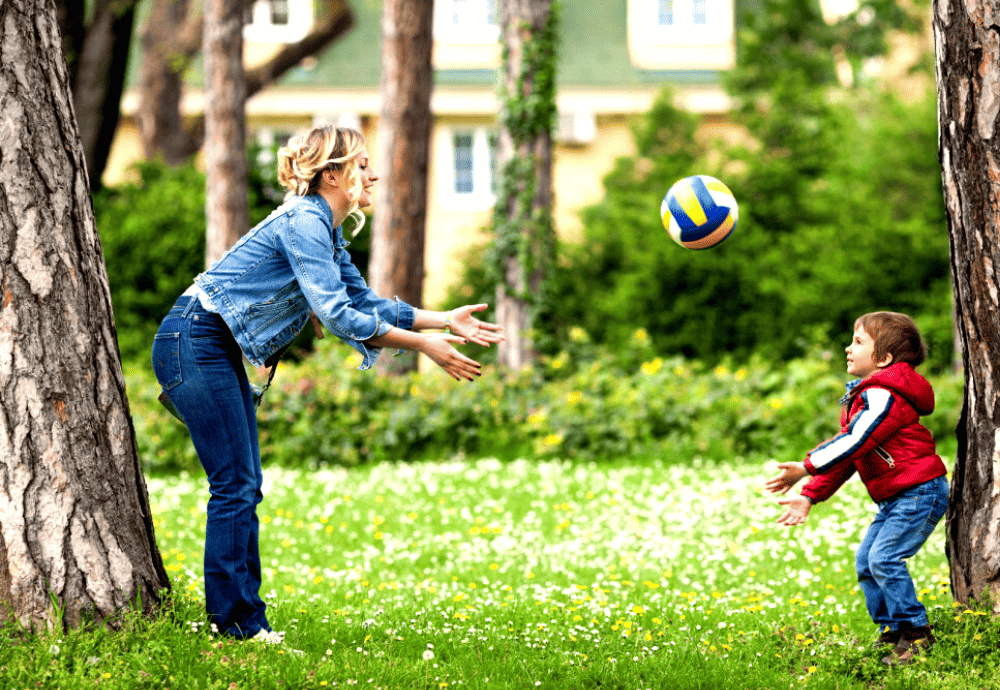Is there anything quite as enjoyable as throwing and catching a ball? It’s relaxing and stimulating at the same time. We have collected throwing games for all ages. We begin this article with a collection of “Throwing Games for Kids.” Then we have some fun “Catching Games” including directions on how to teach someone to catch a ball. Next, we have “Throwing and Catching Games” that combine both abilities. The last section of this article presents “Ball Toss Games” suitable for any age group. Some games we have chosen require small balls, some medium, and some one large ball. Make sure the ball you choose works well with the throwing game you have chosen, and the sizes and ages of your players.
Table of Contents
Throwing games are not only fun, but also develop and improve a person’s life in the following ways:
- Throwing games increase visual attention skills.
- Throwing games develop eye-hand coordination skills.
- Throwing games improve timing and prediction.
- Throwing games improve gross and fine motor skills.
- Throwing games prepare one for sports and other outdoor activities.
Throwing Games for Kids
It is important for a child to learn how to throw so that they can play sports if they wish. Additionally, many school and playground activities involve throwing and catching a ball.
The first thing a child learns in ball handling is the overhand throw. Most children can perform an overhand throw easily. However, accuracy counts when playing most games. Use a target on a wall or the ground to increase accurate throws. Follow these eight steps, beginning slowly and increasing the pace, when teaching how to throw overhand:
- Face the target.
- Place feet shoulder-width apart.
- Lift arm so that ball is pointing to the target and near the ear on the side of the arm they are throwing with.
- Shift weight forward.
- Drop the pointing arm.
- Twist the torso.
- Bring the throw arm forward.
- Release the ball.
The games in this section will increase throwing proficiency while providing fun.
Animal Sounds Throw and Catch
Even the youngest child can play this simple throwing game for kids. Two players simply toss the ball back and forth. For a large group, have the players form a circle. The thrower tosses the ball to another player and while the ball is in the air, calls out the name of the animal and the sound they make. For example, “A cow says, ‘Moo, moo, moo!’” All the players moo while the ball is in the air. Whoever catches the ball chooses another animal and makes the sound that animal makes. The game continues until the players either cannot think of another animal or grow tired.
Dodge Ball
This basic version of dodgeball can be played by young children who are just learning to throw. Make sure you use a soft foam ball and instruct the children to only aim at the legs. You can play this game with just two players or many children. Have a player(s) stand in front of a wall or fence. The thrower attempts to hit the legs of the standing player(s). The standing player(s) dodge the ball and win a point if they are successful. If they manage to catch the thrown ball, they win two points. A player who is hit is out. In a large group, when only one player is left, they are declared the winner. If you have two players, they change places when there is a successful hit. You can also play for points with the first player winning 15 points declared the winner.
Monster Ball
Begin this team game for a large group by dividing in two teams of equal size. This game is played best in a gym or other large area with a hard floor. Give each team a basket or box of balls of different weights and sizes. Between the two teams, set a very large ball. The goal of the game is to force the large ball to the other team’s side by throwing smaller balls at it. A player may not touch the monster ball. If the ball goes out of bounds on the other team’s side of the court, the team doing so wins a point. You can set a time for play and the team with the most points at the end of the set time wins. You can also set a point goal to reach.
Throwing Station Challenge
Set up several stations for the kids to practice throwing. Choose age-appropriate challenges and base the number of the stations on how many players you have. We suggest the following, but you can add more if you wish.
Station 1: Set a ball on top of a box or other object. The goal is to knock the ball to the ground.
Station 2: Have a bucket for the ball to be thrown into.
Station 3: Have a target on the floor or ground for the thrower to hit. You can use tape to make an X.
Station 4: Place a bucket so that it is lying on its side. Use cardboard to make a ramp. The goal is to roll the ball into the bucket.
Pass Five
You will need to play this fast-paced game on a basketball court or other large, hard surfaced area. Players spread out randomly in the play area. One player has the ball and begins play. The goal is to pass the ball to five teammates without dropping the ball or having it intercepted by a player on the other team. If a team completes five passes successfully, they earn one point. Players may not simply pass the ball back and forth between themselves and one other player. If the opposing team intercepts the ball or knocks it down, they get the ball. If the ball goes out of bounds when passed, the other team gets possession. You can set a time for play and the highest scoring team wins, or you can play to a certain preset number of points.
Catching Games
After a child learns to throw the ball, the next logical step is to teach them to catch it. Make sure you teach them the proper way to do so. The first thing they need to do is hold their arms outstretched and close together. They need to keep their eyes on the ball. Teach them to “hug” the ball first. When they have successfully done so several times, they can begin to try to catch it with their hands. The following catching games will improve their catching skills quickly.
Solo Catching
Each person has a ball, and the goal is to catch it in different ways. Our list moves from the easiest to the most difficult throwing method.
- Toss the ball and catch it with both hands.
- Toss the ball at low, medium, and high levels and catch it with both hands.
- Toss the ball with the dominant hand with the other hand behind the back. Again, toss at low, medium, and high levels and catch with both hands.
- Toss and catch with non-dominant hand at low, medium, and high levels with the other hand behind the back,
- Toss and catch the ball switching between right and left (or left and right) hands.
Stunt Catching
Once basic catching is mastered, encourage an attempt at stunt catching. The stunts should be done smoothly one after another. The order of the stunts can vary and create a truly unique display.
- Toss the ball, clap, and catch:
- At a low level, do one clap, and then try medium and high levels with more claps.
- Toss the ball, kneel or sit, and catch.
- Toss the ball, stand, and catch.
- Toss the ball, spin around, and catch.
- Toss the ball, do a pretend action, and catch:
Jumping jack, dance step, reaching hands to the sky, etc.
- Toss the ball behind the back and catch.
- Toss the ball under the leg and catch.
- Place the ball on the instep, balance it, lift leg to toss it, and catch.
- Freestyle:
Toss the ball in any unique and special way.
Point Toss
We have listed this game with our “Catching Games” because all the players except one are catchers. If your players are just learning to throw a ball, have an older child or adult do the throwing. You will need three or more players lined up opposite the thrower. The ball is tossed high in the air and the thrower shouts out a number between 25 and 100. The player who catches the ball without dropping it gets that number of points. If they catch and then drop it, they lose that number of points. When a player reaches a set number of points (500 works well) they win this catching game.
Clap and Catch
Clapping and catching helps players increase their eye-hand coordination and provides a fun variation to simple catching. Put your players in a circle. If you have a large group, you can divide them into pairs. The ball is thrown from person to person with the goal of clapping the hands together before catching the ball. Points are given based on the number of successful claps. If the ball is dropped or a player does not manage to clap before catching the ball, a point is lost. The first player to reach twenty points is the winner.
Bounce and Catch
Similar toe “Clap and Catch,” the goal of this game is to bounce the ball to the other player. There are three ways to play:
- Single Bounce and Catch
This game, as the name implies, requires the players to bounce the ball to each other with a single bounce. Make sure they stand the right distance apart from each other for success. Add a target on the ground if you wish.
- Double Bounce and Catch
Players stand farther apart with the goal to make a double bounce.
- Multiple Bounce and Catch
Have the players stand farther apart. Remember the ball loses its bouncing height and momentum on each successive bounce. The goal is to bounce the ball as many times as possible.
Double Ball Catch
A two-player game, “Double Ball Catch” can be played in a large group by dividing your players into pairs. Each player starts with a ball. The goal is to simultaneously throw the balls to each other. It takes coordination and timing for success. Players attempt to keep the balls going as long as possible without dropping them.
Backwards Catching
As the name implies, the goal is to catch the ball while standing backwards. Pairs of players stand back-to-back and throw or drop the ball over their heads. If players wish to do so, they can add a bounce when throwing. The player who throws should call out, “Ball coming!” as they throw. The goal is to see how many times the ball can be thrown and caught without dropping or missing it.
Throwing and Catching Games
We have included games that involve both the skill of throwing and that of catching. There are several reasons for including throwing and catching games in your collection of ball activities:
- Throwing and catching increase the ability to hit a target and track and receive an object.
- Throwing and catching skills help one be prepared for ball games and other activities.
- Throwing and catching increase one’s ability to process information and predict a trajectory path.
If your players need to have the velocity of the ball slower, have them do underhand throws. As they increase in confidence, they can try overhand throws.
Spud
Number four or more players. Designate a person to serve as thrower who will toss the ball up in the air and call out one of the numbers. The person whose number is called must try to catch or retrieve the ball while all the other players run away. The player who catches the ball shouts, “Spud!” The other players must all freeze in place. The player with the ball may take up to four steps attempting to hit another player by rolling or throwing the ball. A frozen player may not move their feet but can wiggle and twist to avoid the ball. If the ball is caught by the targeted player, the thrower receives one letter – S first, then P, U, D. If the thrower hits a player or the catch is missed, the targeted player gets a letter. Whoever gets the letter throws next. The game continues until someone spells “Spud” and is out of the game. The last player remaining wins this fast-paced game.
Catch and Throw Relay Race
You must have at least four players for this game. Divide your players into two teams. All players stand on the same side of a large yard or playing area. The goal is to get to the other side and back first. The team that does so wins. Only throwing and catching are allowed. Players run in front of each other to get closer to the goal line as they throw and catch. If a ball falls, the team must go back to the starting line.
Rotating Dodgeball
With regular Dodgeball, once you are hit, you are out of the game. With this is a fun variant of dodgeball, you can get back into the game.
As in regular Dodgeball, you must leave the game when you are hit by the ball. However, if the person who threw the ball that hit you is hit and must leave the game, you can go back in. Sometimes this means more than one player returns to the game. Play continues for an allotted time or until one team has most of the players.
Ball Toss Games
The simplest action to take with a ball is to toss it. The games in the section work for any age group and are sure to provide fun. The directions are very simple to understand.
Hot Potato
We have changed the traditional game of Hot Potato, where an object is passed around a circle, and turned it into a more challenging ball toss game. Have the players get in a circle; the size of the circle depends on the number and age of the players. You want players to be far enough apart that the ball can be thrown with ease and caught. Give the ball to the first player. Instruct them to toss the ball to another player in the circle. You can either play music and turn it off or use a timer. The player caught holding the ball is out of the game. The last person left in the circle wins this fast-pass game.
Wall Ball
“Wall Ball,” as the name implies, requires a wall and a bouncy ball that is easy to throw, such as a tennis ball. Three or more people line up across from the wall. The first player throws the ball at the wall, and when it bounces back, players try to catch it and throw it again. If a player is hit by the ball on any part of their body or fails to catch it when they try, they must run to the wall and touch it before the ball is thrown again. If they fail to do so, they receive one strike. If they get three strikes, they are out. The last player remaining wins this active game.
Golf Toss
Set up a miniature golf course in a large play area or outdoor yard with teeing off spots marked with tape or paint (on grass). Set up buckets or cardboard boxes, the number dependent on the age, skill level of your players, and the number playing. The goal is to make a hole in one, or at least get the ball in the bucket or box. Players can either take turns, or, if you have a larger group with many buckets or boxes, they can rotate around working at different tees. Keep track of how many tries each player must make to get the ball in the bucket or box. The player with the lowest score at the end of playing wins.
Chinese Ball
Players of this game that works well for kids over six begin by standing in a circle. Use a ball the size of a basketball. The goal is to throw the ball across the circle, surprising someone so that they do not catch the ball. If a player manages to catch the ball, the players on either side of the catcher raise the arm nearest the player. They hold this position until the ball is thrown to someone else. If a player misses a ball, they are out of the game. Additionally, if a player with their hand held in the air drops their hand before the ball is thrown, they are out. The last five players remaining in the circle are the winners.
Well, I bet you had no idea how many ways a simple ball can be used for entertainment and games. As you play, you will probably think of other ways to use a ball both alone and in a group. Whichever game or activity you choose, have fun!
Susan majored in English with a double minor in Humanities and Business at Arizona State University and earned a Master’s degree in Educational Administration from Liberty University. She taught grades four through twelve in both public and private schools. Subjects included English, U.S. and world history and geography, math, earth and physical science, Bible, information technologies, and creative writing.
Susan has been freelance writing for over ten years, during which time she has written and edited books, newspaper articles, biographies, book reviews, guidelines, neighborhood descriptions for realtors, Power Point presentations, resumes, and numerous other projects.



